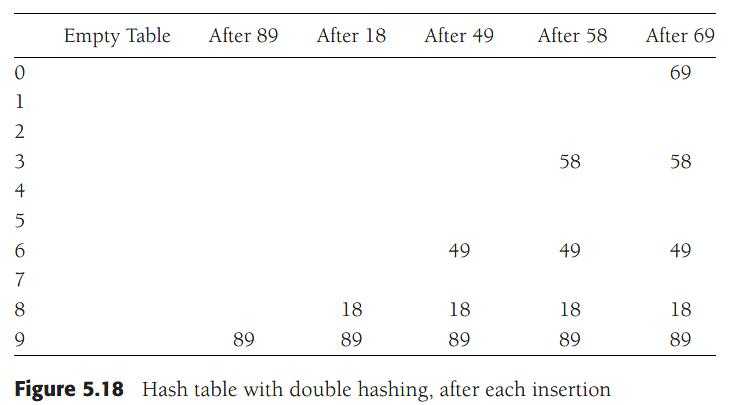标签:ati ISE fine style distance sans beginning str data
Data Structure and Algorithm Analysis in C++
5.4.3 Double Hashing
In the beginning of chapter 5.4, the formula hi(x) = (hash(x) + f(i)) is mentioned and f(i) is defined as f(i) = i ;
Here f(i) is defined as f(i) = i * hash2(x) and hash2(x) = R - (x mod R) where R is a prime smaller than TableSize. If R = 7 then hash2(x) = 7 - (x mod 7).
The case it uses is as followed. Figure 5.18 shows the result of inserting keys {89, 18, 49, 58, 69} into a hash table.

Hash(x), or hash1(x) to be precise, is defined as hash1(x) = x % 10 // TableSize = 10.
So if there‘s no collision, h(x) = hash1(x); otherwise hi(x) = { hash1(x) + i * hash2(x) } % TableSize .
The first collision occurs when 49 is inserted. hash2(49) = 7 ? 0 = 7, so 49 is inserted in position 6 // { 49%10 + (7 - 1* 49%7) } % 10 .
hash2(58) = 7 ? 2 = 5, so 58 is inserted at location 3 // ( 8 + 1*5 )%10 .
Finally, 69 collides and is inserted at a distance hash2(69) = 7?6 = 1 away.
If we tried to insert 60 in position 0, we would have a collision. Since hash2(60) = 7 ? 4 = 3, we would then try positions 3, 6, 9, and then 2 until an empty spot is found.
标签:ati ISE fine style distance sans beginning str data
原文地址:https://www.cnblogs.com/heifengli/p/10225160.html